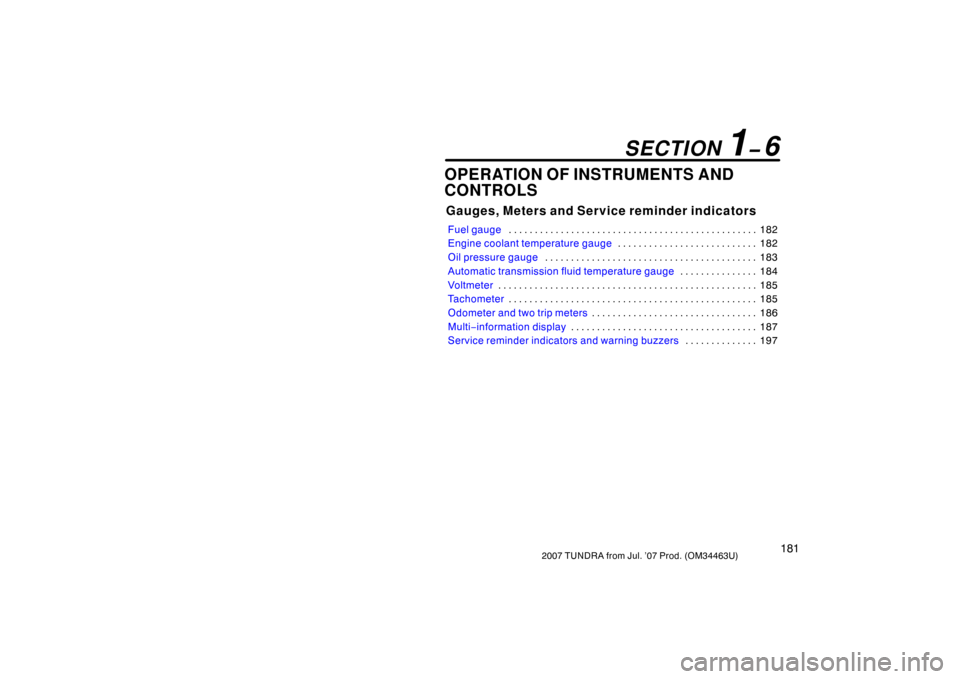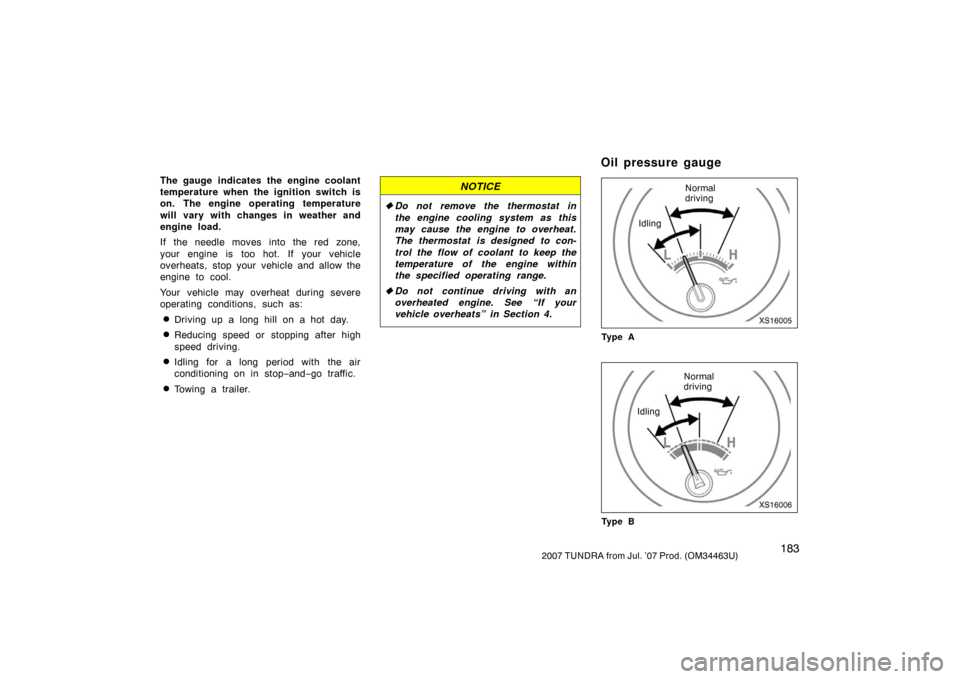Page 21 of 611
122007 TUNDRA from Jul. ’07 Prod. (OM34463U)
XS11002c
1. Tachometer
2. Service reminder indicators andindicator lights
3. Speedometer
4. Fuel gauge 5. Voltmeter
6. Oil pressure gauge
7. Engine coolant temperature gauge
8. Trip meter reset knob
9. Odometer and two trip meters10. Automatic transmission shift position
indicator lights
11. Automatic transmission shift range display
12. Automatic transmission fluid temperature gauge
Instrument cluster overview
�Ty p e A
Page 22 of 611
132007 TUNDRA from Jul. ’07 Prod. (OM34463U)
XS11003c
1. Tachometer
2. Service reminder indicators andindicator lights
3. Speedometer
4. Fuel gauge 5. Voltmeter
6. Oil pressure gauge
7. Engine coolant temperature gauge
8. Trip meter reset knob
9. Multi
−information display 10. Automatic transmission shift position
indicator lights
11. Automatic transmission shift range display
12. Automatic transmission fluid temperature gauge
�
Ty p e B
Page 23 of 611
142007 TUNDRA from Jul. ’07 Prod. (OM34463U)
Driver ’s seat belt reminder light∗1
Low engine oil pressure warning light∗1
Brake system warning light∗1
Charging system warning light∗1
Malfunction indicator lamp∗1
Anti −lock brake system warning light∗
1
SRS warning light∗1
or
Front passenger ’s seat belt reminder light∗1
Passenger airbag on −off indicator light
Engine oil replacement reminder light∗
1
(for vehicles sold in U.S.A.)
Open door warning light∗ 1
Tire pressure warning light∗1
Automatic transmission fluid temperature
warning light∗1
Engine immobilizer/theft deterrent system
indicator lightLow fuel level warning light∗1
Master warning light∗1
Low windshield washer fluid level warning light∗1
or
Indicator symbols on the instrument panel
Page 190 of 611

1812007 TUNDRA from Jul. ’07 Prod. (OM34463U)
OPERATION OF INSTRUMENTS AND
CONTROLS
Gauges, Meters and Service reminder indicators
Fuel gauge182
. . . . . . . . . . . . . . . . . . . . . . . . . . . . . . . . . . . . .\
. . . . . . . . . . .
Engine coolant temperature gauge 182
. . . . . . . . . . . . . . . . . . . . . . . . . . .
Oil pressure gauge 183
. . . . . . . . . . . . . . . . . . . . . . . . . . . . . . . . . . . . \
. . . . .
Automatic transmission fluid temperature gauge 184
. . . . . . . . . . . . . . .
Vo ltme te r 185
. . . . . . . . . . . . . . . . . . . . . . . . . . . . . . . . . . . . \
. . . . . . . . . . . . . .
Tachometer 185
. . . . . . . . . . . . . . . . . . . . . . . . . . . . . . . . . . . . \
. . . . . . . . . . . .
Odometer and two trip meters 186
. . . . . . . . . . . . . . . . . . . . . . . . . . . . . . . .
Multi −information display 187
. . . . . . . . . . . . . . . . . . . . . . . . . . . . . . . . . . . . \
Service reminder indicators and warning buzzers 197
. . . . . . . . . . . . . .
SECTION 1� 6
Page 192 of 611

1832007 TUNDRA from Jul. ’07 Prod. (OM34463U)
The gauge indicates the engine coolant
temperature when the ignition switch is
on. The engine operating temperature
will vary with changes in weather and
engine load.
If the needle moves into the red zone,
your engine is too hot. If your vehicle
overheats, stop your vehicle and allow the
engine to cool.
Your vehicle may overheat during severe
operating conditions, such as:
�Driving up a long hill on a hot day.
�Reducing speed or stopping after high
speed driving.
�Idling for a long period with the air
conditioning on in stop−and− go traffic.
�Towing a trailer.
NOTICE
�Do not remove the thermostat in
the engine cooling system as this
may cause the engine to overheat.
The thermostat is designed to con-
trol the flow of coolant to keep the
temperature of the engine within
the specified operating range.
� Do not continue driving with an
overheated engine. See “If your
vehicle overheats” in Section 4.
XS16005
Normal
driving
Idling
Ty p e A
XS16006
Normal
driving
Idling
Ty p e B
Oil pressure gauge
Page 193 of 611

1842007 TUNDRA from Jul. ’07 Prod. (OM34463U)
The oil pressure gauge indicates engine
oil pressure when the ignition switch is
on. Check it while driving to make sure
that the needle is in the proper range.
If the oil pressure should stay below the
normal range, pull off the road to a safe
place and stop the engine immediately.
Call a Toyota dealer or qualified repair
shop for assistance.
Oil pressure may not build up when the
oil level is too low. The oil pressure
gauge is not designed to indicate oil level,
and the oil level must be checked using
the level dipstick.
NOTICE
Do not drive the vehicle with the oil
pressure below the normal range until
the cause is fixed—it may ruin the
engine.
XS16015c
High range
Ty p e A
XS16016c
High range
Ty p e B
Automatic transmission fluid tempera-
ture gauge indicates automatic trans-
mission fluid temperature when the
ignition switch is on. Check it while
driving to make sure that the needle is
in the proper range.
The gauge displays the current tempera-
ture of the automatic transmission fluid.
The gauge informs the driver of changes
in the automatic transmission fluid temper-
ature especially if it becomes too high
while towing a heavy trailer or hauling a
heavy load.
If the needle reads high range while you
are driving, slow down and pull off the
road. Stop the vehicle at a safe place and
put the selector lever in “P”. With the
engine idling, wait until the needle reads
below the high range. If the needle reads
below the high range, you may start the
vehicle again. If the needle reads the high
range, call a Toyota dealer or qualified
repair shop for assistance.
NOTICE
Continued driving with reading in the
high range may damage the automatic
transmission.
Automatic transmission fluid
temperature gauge (with
towing package)
Page 203 of 611
1942007 TUNDRA from Jul. ’07 Prod. (OM34463U)
MessageStatusAction
(d)Fuel in tank becomes nearly empty.Fill up tank.
(e)Automatic transmission fluid temperature is
too high.Stop and check.
(f)Oil change is nearly due.Check engine oil.
(g)Oil change is due.Replace engine oil.
(h)Washer fluid level is low.Add washer fluid.
Page 451 of 611

4422007 TUNDRA from Jul. ’07 Prod. (OM34463U)
�To allow proper operation of your
vehicle’s ventilation system, keep
the inlet grilles in front of the wind-
shield clear of snow, leaves, or oth-
er obstructions.
�If you smell exhaust fumes in the
vehicle, open the windows and
close the rear window to ensure
plenty of fresh air enters the ve-
hicle. If you can smell exhaust
fumes even though there are no
other vehicles in the surrounding
area, have your vehicle checked by
your Toyota dealer. Continued in-
halation of exhaust fumes can lead
to death by gas poisoning.
�Toyota does not recommend occu-
pying the rear cargo area when it
is fitted with a slide�in camper,
camper shell or other type cover
while the engine is running. This
caution applies to both driving and
stopped or parked situations with
the engine running. Particular care
should be taken to prevent exhaust
gases from entering camper bodies,
trailers or other enclosures on or
around your vehicle. If exhaust
fumes are detected, open all win-
dows and thoroughly ventilate the
area.FUNCTIONS OF ENGINE OIL
Engine oil has the primary functions of
lubricating and cooling the inside of the
engine, and plays a major role in main-
taining the engine in proper working order.
ENGINE OIL CONSUMPTION
It is normal that an engine should con-
sume some engine oil during normal
engine operation. The causes of oil
consumption in a normal engine are as
follows.
�Oil is used to lubricate pistons, piston
rings and cylinders. A thin film of oil
is left on the cylinder wall when a pis-
ton moves downwards in the cylinder.
High negative pressure generated when
the vehicle is decelerating sucks some
of this oil into the combustion chamber.
This oil as well as some part of the oil
film left on the cylinder wall is burned
by the high temperature combustion
gases during the combustion process.
�Oil is also used to lubricate the stems
of the intake valves. Some of this oil
is sucked into the combustion chamber
together with the intake air and is
burned along with the fuel. High tem-
perature exhaust gases also burn the
oil used to lubricate the exhaust valve
stems.
Facts about engine oil
consumption